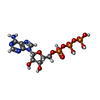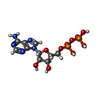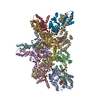+Search query
-Structure paper
| Title | Molecular basis for transposase activation by a dedicated AAA+ ATPase. |
|---|---|
| Journal, issue, pages | Nature, Vol. 630, Issue 8018, Page 1003-1011, Year 2024 |
| Publish date | Jun 26, 2024 |
 Authors Authors | Álvaro de la Gándara / Mercedes Spínola-Amilibia / Lidia Araújo-Bazán / Rafael Núñez-Ramírez / James M Berger / Ernesto Arias-Palomo /   |
| PubMed Abstract | Transposases drive chromosomal rearrangements and the dissemination of drug-resistance genes and toxins. Although some transposases act alone, many rely on dedicated AAA+ ATPase subunits that ...Transposases drive chromosomal rearrangements and the dissemination of drug-resistance genes and toxins. Although some transposases act alone, many rely on dedicated AAA+ ATPase subunits that regulate site selectivity and catalytic function through poorly understood mechanisms. Using IS21 as a model transposase system, we show how an ATPase regulator uses nucleotide-controlled assembly and DNA deformation to enable structure-based site selectivity, transposase recruitment, and activation and integration. Solution and cryogenic electron microscopy studies show that the IstB ATPase self-assembles into an autoinhibited pentamer of dimers that tightly curves target DNA into a half-coil. Two of these decamers dimerize, which stabilizes the target nucleic acid into a kinked S-shaped configuration that engages the IstA transposase at the interface between the two IstB oligomers to form an approximately 1 MDa transpososome complex. Specific interactions stimulate regulator ATPase activity and trigger a large conformational change on the transposase that positions the catalytic site to perform DNA strand transfer. These studies help explain how AAA+ ATPase regulators-which are used by classical transposition systems such as Tn7, Mu and CRISPR-associated elements-can remodel their substrate DNA and cognate transposases to promote function. |
 External links External links |  Nature / Nature /  PubMed:38926614 / PubMed:38926614 /  PubMed Central PubMed Central |
| Methods | EM (single particle) |
| Resolution | 3.18 - 3.62 Å |
| Structure data | EMDB-18136, PDB-8q3w: EMDB-18144, PDB-8q4d: |
| Chemicals |  ChemComp-MG:  ChemComp-ATP:  ChemComp-ADP: |
| Source |
|
 Keywords Keywords | DNA BINDING PROTEIN / DNA Transposition / transposon / transpososome / AAA+ ATPases / target DNA / IS21 / IstB / Insertion sequence / cryo-electron microscopy. / DNA integration / holo-transpososome / IstA / DDE transposase / DDE domain / AAA+ ATPase / DNA strand transfer complex / STC |
 Movie
Movie Controller
Controller Structure viewers
Structure viewers About Yorodumi Papers
About Yorodumi Papers







 geobacillus stearothermophilus (bacteria)
geobacillus stearothermophilus (bacteria)